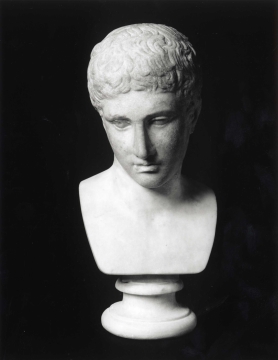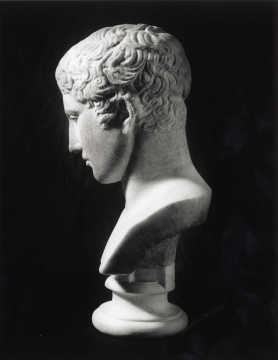Explore Collections


You are here:
CollectionsOnline
/
Polykleitan head of the so-called 'Westmacott Athlete' type.
Browse
Polykleitan head of the so-called 'Westmacott Athlete' type.
Coarse-grained Parian marble, with modern base in Italian marble
Height: 42.5cm
Height (excluding restoration): 22cm
Height (excluding restoration): 22cm
Museum number: M974
On display: Dome Area
All spaces are in No. 13 Lincoln's Inn Fields unless identified as in No. 12, Soane's first house.
For tours https://www.soane.org/your-visit
Curatorial note
A good, although somewhat battered copy of a Greek fifth century BC bronze original thought to represent the victorious athlete Kyniskos and known best from the marble copy in the British Museum2 which is called the Westmacott Athlete after its previous owner, the sculptor Sir Richard Westmacott, R.A. (1775-1856). The type considered as representing the boy boxer in the act of placing the victor's wreath on his brow with his right hand, has long been attributed on grounds of style to Polykleitos of Argos, the sculptor of the Doryphoros, of which a small marble replica is preserved in Soane's collection (M1022/Vermeule 363).
The identification as Kyniskos is made on the basis of an inscribed statue base found in the excavations at Olympia3 which is dated in the decade after the middle of the fifth century BC, and the fact that the foot positions of this lost bronze correspond to those of the copies.4 There has been a question whether the statue preserved in the Westmacott type is by the master or whether, if not the type of the signed Kyniskos base, it is attributable to a later pupil working in this phase of Polykleitos' style.5 Hyde has shown that while Polykleitos' statue at Olympia and the Westmacott replicas may represent the original and most famous version of the type, the figure was adapted in Attic sculpture of the fourth century BC and has identified several variant youths in this pose and modified style which are either later Greek originals or Roman copies of others now lost. The works of Polykleitos have been the subject of numerous publications by archaeologists in addition to the references cited above. These references and the antique sources may be best surveyed by reading R. Bianchi Bandinelli6 and the Westmacott Athletic type itself by studying D.M. Robinson's article.7 A more modern compendium of the various Polykleitan replicas can be found in the Bol/Beck 1990 exhibition catalogue, Polyklet (see references).
The Soane head has the hair treated in a manner not far distant from, but definitely softer than, the British Museum copy. In this respect it finds a close stylistic parallel in the head of a boy found in the Emperor Domitian's villa near the Alban Lake, at Castelgandolfo in Italy, and now in the Museo delle Terme, Rome.8 The measurements of this Soane head correspond exactly with those of the head in the Hermitage Museum, St Petersburg, as given by Furtwangler (see footnote 1) which are: L (of head): 19 cm; L (of face): 14.8 cm; L (of eyeball): 2.7 cm; W (of mouth): 13.9 cm; Distance from eye to hair: 5.8 cm; L (of right ear): 5.4 cm; L (from temple to temple (hairline) at eye level: 18 cm.
The popularity of the Westmacott Athlete type, and therefore the probability that the original was by Polykleitos rather than a follower, is confirmed by the statue's appearance as a late Hellenistic statuette in terracotta. These terracottas of the Westmacott Athlete or of the Diadumenos (Fillet-Binder) were manufactured along the Ionian coast of Greece, probably at Smyrna, in a region where copies of the statues could have stood and where (at Ephesos) one famous Polykleitan original (the Amazon) is documented.9
1 A. Furtwängler, Masterpieces of Greek Sculpture, ed. and trans. E. Sellers, 2 vols, London, 1895, p. 251f. l, fig. 104; Oscar Waldhauer, Die Antiken Skulpturen der Hermitage, p. 12, no. 99.
2 A.H. Smith, Catalogue of Sculpture in the department of Greek and Roman antiquities, British Museum, Vol. III, no.1754.
3 E.M. Loewy, Inschriften Griechischer Bildhauer, no. 56.
4 G.M.A. Richter, The Sculpture and Sculptors of the Greeks, New Haven, 1929, p. 252.
5 Walter Hyde, Olympic Victor Monuments & Greek Athletic Art, 1921, p. 156ff.
6 R. Bianchi Bandinelli, Quaderni per lo studio dell'archeologia 1, Policleto, 1938. For recent studies on Polykleitos see generally: H. Beck/P.C. Bol (eds.), Polykletforschungen, Berlin 1993.
7 David M. Robinson, 'The Cyniscus of Polyclitus', Art Bulletin, Vol. 18, No. 2, June 1936, pp.133-149.
8 Robinson, op. cit. p. 139f., fig. 9.
9 See generally, Cornelius Vermeule, Polykleitos, Boston 1969, passim.
The identification as Kyniskos is made on the basis of an inscribed statue base found in the excavations at Olympia3 which is dated in the decade after the middle of the fifth century BC, and the fact that the foot positions of this lost bronze correspond to those of the copies.4 There has been a question whether the statue preserved in the Westmacott type is by the master or whether, if not the type of the signed Kyniskos base, it is attributable to a later pupil working in this phase of Polykleitos' style.5 Hyde has shown that while Polykleitos' statue at Olympia and the Westmacott replicas may represent the original and most famous version of the type, the figure was adapted in Attic sculpture of the fourth century BC and has identified several variant youths in this pose and modified style which are either later Greek originals or Roman copies of others now lost. The works of Polykleitos have been the subject of numerous publications by archaeologists in addition to the references cited above. These references and the antique sources may be best surveyed by reading R. Bianchi Bandinelli6 and the Westmacott Athletic type itself by studying D.M. Robinson's article.7 A more modern compendium of the various Polykleitan replicas can be found in the Bol/Beck 1990 exhibition catalogue, Polyklet (see references).
The Soane head has the hair treated in a manner not far distant from, but definitely softer than, the British Museum copy. In this respect it finds a close stylistic parallel in the head of a boy found in the Emperor Domitian's villa near the Alban Lake, at Castelgandolfo in Italy, and now in the Museo delle Terme, Rome.8 The measurements of this Soane head correspond exactly with those of the head in the Hermitage Museum, St Petersburg, as given by Furtwangler (see footnote 1) which are: L (of head): 19 cm; L (of face): 14.8 cm; L (of eyeball): 2.7 cm; W (of mouth): 13.9 cm; Distance from eye to hair: 5.8 cm; L (of right ear): 5.4 cm; L (from temple to temple (hairline) at eye level: 18 cm.
The popularity of the Westmacott Athlete type, and therefore the probability that the original was by Polykleitos rather than a follower, is confirmed by the statue's appearance as a late Hellenistic statuette in terracotta. These terracottas of the Westmacott Athlete or of the Diadumenos (Fillet-Binder) were manufactured along the Ionian coast of Greece, probably at Smyrna, in a region where copies of the statues could have stood and where (at Ephesos) one famous Polykleitan original (the Amazon) is documented.9
1 A. Furtwängler, Masterpieces of Greek Sculpture, ed. and trans. E. Sellers, 2 vols, London, 1895, p. 251f. l, fig. 104; Oscar Waldhauer, Die Antiken Skulpturen der Hermitage, p. 12, no. 99.
2 A.H. Smith, Catalogue of Sculpture in the department of Greek and Roman antiquities, British Museum, Vol. III, no.1754.
3 E.M. Loewy, Inschriften Griechischer Bildhauer, no. 56.
4 G.M.A. Richter, The Sculpture and Sculptors of the Greeks, New Haven, 1929, p. 252.
5 Walter Hyde, Olympic Victor Monuments & Greek Athletic Art, 1921, p. 156ff.
6 R. Bianchi Bandinelli, Quaderni per lo studio dell'archeologia 1, Policleto, 1938. For recent studies on Polykleitos see generally: H. Beck/P.C. Bol (eds.), Polykletforschungen, Berlin 1993.
7 David M. Robinson, 'The Cyniscus of Polyclitus', Art Bulletin, Vol. 18, No. 2, June 1936, pp.133-149.
8 Robinson, op. cit. p. 139f., fig. 9.
9 See generally, Cornelius Vermeule, Polykleitos, Boston 1969, passim.
Purchased by Soane at the sale of the effects of Lord Berwick at Attingham Park, Shropshire (Mr. Robins) 6 August 1827, Lot. 66, A bust of Augustus Caesar, when a Boy, sculptured in marble and mounted on a plinth, for £3.3.0.
Literature
A. Michaelis, The Ancient Marbles of Great Britain, (trans. C.A.M. Fennell, Cambridge, 1882), p.475, no.10.
Description of Sir John Soane's Museum, 1930, p. 84.
David M. Robinson, 'The Cyniscus of Polyclitus', Art Bulletin, Vol. 18, No. 2, June, 1936, p.149, no.28.
Carlo Anti, 'Monumenti Policletei', in Monumenti Antichi XXVI (1920), p.591, note 3, no.16.
W. Amelung, in Berliner philologische Wochenschrift, 1902, p.273.
A. Linfert, 'Aus Anla neuer Repliken des Westmacottschen Epheben und des Dresdner Knaben' in Polyklet: Der Bildhauer der griechischen Klassik, ed. Herbert Beck and Peter Bol, exhibition catalogue, Frankfurt am Main, 1990, no. 38, p. 93, pl. 42, 44, 75 [pp. 141-192].
Alexander Cambitoglu,[Review of Zum Epheben Westmacott by German Hafner], American Journal of Archaeology, Vol. 63, No. 3 (July 1959), p. 308.
Polyklet: Der Bildhauer der griechischen Klassik, exhibition catalogue, Frankfurt am Main, 1990, cat. no. 113, pp. 592-93.
A New Description of Sir John Soane's Museum, 2010, p. 59.
Description of Sir John Soane's Museum, 1930, p. 84.
David M. Robinson, 'The Cyniscus of Polyclitus', Art Bulletin, Vol. 18, No. 2, June, 1936, p.149, no.28.
Carlo Anti, 'Monumenti Policletei', in Monumenti Antichi XXVI (1920), p.591, note 3, no.16.
W. Amelung, in Berliner philologische Wochenschrift, 1902, p.273.
A. Linfert, 'Aus Anla neuer Repliken des Westmacottschen Epheben und des Dresdner Knaben' in Polyklet: Der Bildhauer der griechischen Klassik, ed. Herbert Beck and Peter Bol, exhibition catalogue, Frankfurt am Main, 1990, no. 38, p. 93, pl. 42, 44, 75 [pp. 141-192].
Alexander Cambitoglu,[Review of Zum Epheben Westmacott by German Hafner], American Journal of Archaeology, Vol. 63, No. 3 (July 1959), p. 308.
Polyklet: Der Bildhauer der griechischen Klassik, exhibition catalogue, Frankfurt am Main, 1990, cat. no. 113, pp. 592-93.
A New Description of Sir John Soane's Museum, 2010, p. 59.
Exhibition history
Polyklet: Der Bildhauer der Griechischen Klassik, Liebieghaus Skulpturensammlung, Frankfurt am Main, October 1990 - January 1991
Soane collections online is being continually updated. If you wish to find out more or if you have any further information about this object please contact us: worksofart@soane.org.uk







